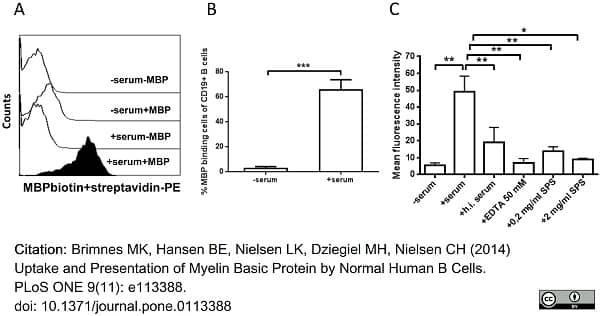- Reagents In The Kit
-
LNK263B: 1 Vial of 1mg LYNX Rapid Plus lyophilized Biotin mix
1 Vial LYNX Modifier reagent
1 Vial LYNX Quencher reagent
-
LNK262B: 3 Vials of 100μg LYNX Rapid Plus lyophilized Biotin mix.
1 Vial LYNX Modifier reagent.
1 Vial LYNX Quencher reagent.
-
LNK261B: 3 Vials of 10μg LYNX Rapid Plus lyophilized Biotin mix.
1 Vial LYNX Modifier reagent.
1 Vial LYNX Quencher reagent.
- Preparing The Antibody
-
LNK263B: The following buffer solutions are recommended:for preparing the antibody:
10-50mM amine-free buffer (e.g HEPES, MES, MOPS and phosphate) pH range 6.5-8.5, although moderate concentrations of Tris buffer (<20mM) may be tolerated.
Do not use buffers containing nucleophilic components (e.g primary amines), thiols (e.g. Thiomersal/Thimerosal), Merthiolate, Glycine or Proclin. These substances may react with LYNX chemicals. Azide (0.02-0.1%), EDTA and common non-buffering salts and sugars have little or no effect on conjugation efficiency.
It is recommended that up to 2mg antibody be used in each labeling reaction. For optimal results the antibody volume should be 400-1000μl, at a concentration range between 1mg/ml and 2.5 mg/ml.
-
LNK262B: The following buffer solutions are recommended:for preparing the antibody:
10-50mM amine-free buffer (e.g HEPES, MES, MOPS and phosphate) pH range 6.5-8.5, although moderate concentrations of Tris buffer (<20mM) may be tolerated.
Do not use buffers containing nucleophilic components (e.g primary amines), thiols (e.g. Thiomersal/Thimerosal), Merthiolate, Glycine or Proclin. These substances may react with LYNX chemicals. Azide (0.02-0.1%), EDTA and common non-buffering salts and sugars have little or no effect on conjugation efficiency.
It is recommended that up to 100-200 μg antibody be used in each labeling reaction. For optimal results the antibody volume should be 40-100 μl, at a concentration range between 1mg/ml and 2.5 mg/ml.
-
LNK261B: The following buffer solutions are recommended:for preparing the antibody:
10-50mM amine-free buffer (e.g HEPES, MES, MOPS and phosphate) pH range 6.5-8.5, although moderate concentrations of Tris buffer (<20mM) may be tolerated.
Do not use buffers containing nucleophilic components (e.g primary amines), thiols (e.g. Thiomersal/Thimerosal), Merthiolate, Glycine or Proclin. These substances may react with LYNX chemicals. Azide (0.02-0.1%), EDTA and common non-buffering salts and sugars have little or no effect on conjugation efficiency.
It is recommended that up to 10-20 μg antibody be used in each labelling reaction. For optimal results the antibody volume should be 4-10 μl, at a concentration range between 1mg/ml and 2.5 mg/ml.
- Regulatory
-
LNK263B: For research purposes only.
-
LNK262B, LNK261B: For research purposes only
- Guarantee
- 12 months from date of despatch
- Licensed Use
-
LNK263B: Bio-Rad LYNX Rapid Plus Conjugation kits are offered for research purposes alone, and are not intended for human, therapeutic or diagnostic use. The purchase of this conjugation kit conveys to the buyer (whether the buyer is a
not-for-profit, academic or for-profit entity) the non-transferable
right to use the amount of product purchased and
the components of the product for in-house research. The
buyer shall not sell or otherwise transfer this product, its
components, or materials prepared therefrom to any third
party. The buyer shall not use this product or its components
for commercial purposes. For the avoidance of doubt,
?commercial purposes? means any activity by a party for
consideration and includes, without limitation, use of the
product or its components (I) in the manufacturing of
conjugated materials (e.g. labeled antibodies), (ii) to provide
a service, information or data, (iii) for therapeutic, diagnostic
or prophylactic purposes, or (iv) for repackaging/resale,
whether or not such product or its components are resold for
use in research. The use of this product by the buyer
constitutes agreement with the terms of this limited use label
license for LYNX products.
-
LNK262B, LNK261B: Bio-Rad LYNX Rapid Plus Conjugation kits are offered for research purposes alone, and are not intended for human, therapeutic or diagnostic use. The purchase of this conjugation kit conveys to the buyer (whether the buyer is a
not-for-profit, academic or for-profit entity) the non-transferable
right to use the amount of product purchased and
the components of the product for in-house research. The
buyer shall not sell or otherwise transfer this product, its
components, or materials prepared therefrom to any third
party. The buyer shall not use this product or its components
for commercial purposes. For the avoidance of doubt,
‘commercial purposes’ means any activity by a party for
consideration and includes, without limitation, use of the
product or its components (I) in the manufacturing of
conjugated materials (e.g. labeled antibodies), (ii) to provide
a service, information or data, (iii) for therapeutic, diagnostic
or prophylactic purposes, or (iv) for repackaging/resale,
whether or not such product or its components are resold for
use in research. The use of this product by the buyer
constitutes agreement with the terms of this limited use label
license for LYNX products.

